
- December digital edition 2020
- Volume 12
- Issue 12
New ways to keep dry eye patients comfortable in contact lenses
New contact lens releases moisturizers during wear to maintain homeostasis
As a dry eye specialist, one of my biggest challenges is keeping my patients in contact lenses. My practice’s contact lens orders have been over 90 percent daily disposables for years now. But for extreme dry eye patients, daily disposables alone, aren’t enough to keep them comfortable or compliant.
The problems at hand
Contact lenses pose several innate challenges to the ocular surface. Upon application, contact lenses split the tear film in half. Lens wear, over time, causes destabilization of the tear film and quickens the rate of tear film evaporation.1-3
Evaporation causes poor wettability of the lens which leads to discomfort, but also deposition, further dehydration, and sensitivities. I have personally compared the blink rate, partial blink occurrence, and lipid layer thickness with and without contact lenses in many of my patients using Lipi-View (Johnson & Johnson Vision).
I find patients blink less frequently, have a higher incidence of partial blinks, and a slightly lower lipid layer thickness when wearing contact lenses versus when the test was repeated without contact lenses. Though my sample size was small, findings do make sense when considering the effect of corneal desensitization and should get ODs thinking.
Both tear film break-up time (TBUT) and tear volume have been found to be significantly reduced in contact lens wearers.4
Evaporative stress creates inflammation. In fact, a variety of inflammatory mediators (including interleukin IL-6, IL-8, and tumor necrosis factor (TNF-α) have been found to be upregulated in the tears of contact lens wearers.4
As ODs know, inflammation is often the root cause of dry eye and is also the culprit in escalating the severity of any ocular surface disease. Furthermore, while silicone gives us the highest oxygen permeability, it is an innately hydrophobic material.
The leading silicone hydrogel daily disposable lenses are Dailies Total 1 (Alcon) and Acuvue Oasys 1-Day (Johnson & Johnson Vision). My personal go-to lens for dry eye patients is Dailies Total 1. Many patients are unable to tolerate any other lens. However, as anything else, silicone hydrogel daily disposable lenses don’t work for every patient. Some patients are sentenced to spectacle correction only.
New moisture technology
Recently, I was introduced to Bausch & Lomb’s new daily disposable, premium, silicone hydrogel lens, Infuse. All I can say is, “Halleluiah!”
While Infuse is B+L’s latest entry into the marketplace, as of writing this, it is not yet available in offices. While I don’t usually write about lenses or new technology until I have trialed with at least dozens of patients, I am compelled to proceed due to the overwhelming patient need and amazing potential at hand.
I tried this first on myself, because, as a previous high myope and post laser-assisted in-situ keratomileusis (LASIK) patient, I had problems with dryness, clarity, and stability of vision when wearing contact lenses over my extra-flat corneas. I was able to wear this lens comfortably for the entire day. At removal, my vision was better with the contact lenses in versus out. This is an enormous accomplishment for me!
The goal of the ocular surface is to maintain homeostasis. This is threatened with the presence of a contact lens. The motto for this lens might as well be, “Do no harm.”
Infuse has osmoprotectants, electrolytes, and moisturizers that are released during wear to help maintain homeostasis. This is profound. We have long been hearing about the potential to use contact lenses as a drug delivery system, so using this method to increase contact lens comfort seems intuitive and long overdue.
Some of the proprietary ingredients are retained in the lens throughout the 16-hour day to ensure wettability and compatibility, according to the company. Not only has the lens been shown to retain moisture, but the lens modulus is quite low at 0.5, making it easy to handle and less obstructive on the ocular surface. In addition, it boasts a high oxygen permeability (Dk/t) of 134.5
Infuse has aspheric optics, which is also key, considering how frequently ODs mask astigmatism in dry eye patients, in order to get them into a better material, or fit post-LASIK dry eye patients that have inherent aberrations (like me). This is a distinguishable difference from Dailies Total 1 or Oasys 1-Day. Infuse is available in powers +6.00 D to -12.00 D, with a 8.6 mm base curve, 14.2 mm diameter, 55 percent water content, visitint, and ultraviolet (UV) blocking.5
So far, I have received tremendous feedback from patients who have tried Infuse, and I am anxious to offer it to more dry eye sufferers desperate for freedom from spectacles.
Will new technology be enough?
Some contact lens patients know they are dry, while others have the ocular signs of dryness without symptoms. This is initially perpetuated by the ability of contact lenses to desensitize the cornea. For the purpose of discussion, let’s consider both groups to be dry eye contact lens patients.
Of course, fit these patients in daily disposable lenses, preferably a premium lens designed with enhanced moisture retention properties.
But please—don’t stop there. Whether they have symptoms or not, show patients the changes you see on their ocular surfaces and educate them on the need to initiate underlying treatments as soon as possible to prevent progression.
This is not always an easy discussion, but one that patients deserves. Consider recommending omega supplements to all contact lens wearers. But for those with concerns, consider early initiation of anti-inflammatory pharmaceuticals to further reduce the inflammatory response.
This is typically a reasonable recommendation considering many contact lens patients are under age 65 and still on commercial health insurance with better drug coverage. Another simple route for dry eye contact lens patients is to offer intense pulsed light (IPL) therapy or in-office thermal expression which, in mild cases, limits or eliminates the need for home maintenance and may fit better with an active lifestyle.
Contact lenses seem counterintuitive in a dry eye practice, and even in direct opposition at times. That is why I am so excited to have a new option for my dry eye contact lens patients that may offer them the same privileges and freedoms other patients enjoy.
Don’t assume patients will not pay for a premium lens. Show them their ocular surfaces and what makes premium technology specifically advantageous and even protective in preventing quicker progression compared to value lenses.
Use resources to answer questions for patients about why something so freeing for their lifestyle doesn’t have to be an antagonist to their ocular surfaces. If you don’t offer a solution, they may find another doctor who will.
References
1. Tomlinson A, Cedarstaff T. Tear Evaporation from the Human Eye - Effect of Contact Lens Wear. J Brit Contact Lens Assoc 1982;5:141-150.
2. Young G, Efron N. Characteristics of the pre-lens tear films during hydrogel contact lens wear. Ophthalmic Physiol Opt 1991;11:53-58.
3. Holden BA, Williams L, Sweeney DF, Swarbrick HA. The endothelial response. Holden BA, Williams L, Sweeney DF, Swarbrick HA. The endothelial response to contact lens wear. CLAO J. 1986 Jul-Sep;12(3):150-2.
4. Glasson MJ, Stapleton F, Keay L, Sweeney D, Willcox MD. Differences in clinical parameters and tear film of tolerant and intolerant contact lens wearers. Invest Ophthalmol Vis Sci. 2003 Dec;44(12):5116-24.
5. Bausch + Lomb website. Infuse. Available at: https://www.bauschinfuse.com/ecp/. Accessed 11/29/20.
Articles in this issue
about 5 years ago
ODs look back on 2020about 5 years ago
Cataract surgery 2020 updateabout 5 years ago
Long-term follow-up of angiod streaksabout 5 years ago
Can AI rescue physicians from EHR woes?about 5 years ago
How to handle dry eye follow-up visitsabout 5 years ago
Quiz: Know the ocular effects of eyelash growth serumsabout 5 years ago
Know the ocular effects of eyelash growth serumsabout 5 years ago
Quiz answers: Know the ocular effects of eyelash growth serumsabout 5 years ago
How to manage orbital fracturesabout 5 years ago
Navigate postop IOP control with wound burpingNewsletter
Want more insights like this? Subscribe to Optometry Times and get clinical pearls and practice tips delivered straight to your inbox.













































.png)


